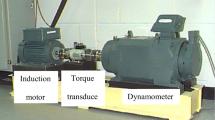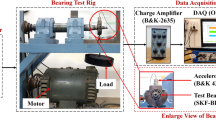Abstract
Recently, with the development of the 4th industrial technology such as big data, cloud computing, and IoT, technologies that automatically perform specific tasks without human intervention are being applied in many industrial sites. In the case of rotating equipment diagnosis, features are extracted based on the shape and statistical information of the time and frequency signals of the vibration data for each location, and the acquired data is classified as normal or defective by learning it. However, since this method used the shape and statistical information of the vibration signals, the physical meaning is blurred and the information is not meaningful for actual diagnosis, resulting in inconsistent learning models even in the same facility.
In this study, the possibility of classifying normal and fault condition were confirmed by generating images considering the fault component and sensor location of the vibration signal and applying to CNN-based deep learning technology. As a method of performing image processing, STFT is performed on the acquired vibration signal data for each position to generate an image. In addition, converting each sensor position attached to red, green, and blue to express location information, resynthesis was performed to configure learning data and create a classification model. In order to verify this method, verification was performed based on the data acquired for the gearbox system to confirm the possibility of classifying the fault condition.
Similar content being viewed by others
Abbreviations
- n :
-
Sample number
- m :
-
Window length
- f :
-
Frequency
- x (n):
-
Time-domain signal
- w (m):
-
Window function
References
J. Endrenyi et al., The present status of maintenance strategies and the impact of maintenance on reliability, IEEE Transactions on Power Systems, 16 (4) (2001) 638–646.
E. A. Udren, Protection system maintenance program choices - TBM, CBM, and PBM, 2014 67th Annual Conference for Protective Relay Engineers (2014) 10–22.
D. Kateris et al., A machine learning approach for the condition monitoring of rotating machinery, Journal of Mechanical Science and Technology, 28 (1) (2014) 61–71.
R. Liu et al., Artificial intelligence for fault diagnosis of rotating machinery: A review, Mechanical Systems and Signal Processing, 108 (2018) 33–47.
N. E. Sepulveda and J. Sinha, Parameter optimisation in the vibration-based machine learning model for accurate and reliable faults diagnosis in rotating machines, Machines, 8 (4) (2020) 66.
H. Yang, J. Mathew and L. Ma, Vibration feature extraction techniques for fault diagnosis of rotating machinery: A literature survey, Asia-Pacific Vibration Conference, Gold Coast, Australia (2003).
T. Yu et al., Leak detection in water distribution systems by classifying vibration signals, Mechanical Systems and Signal Processing, 185 (2023) 109810.
H. T. Yu et al., Novelty class detection in machine learning-based condition diagnosis, Journal of Mechanical Science and Technology, 37 (3) (2023) 1145–1154.
Y. LeCun et al., Backpropagation applied to handwritten zip code recognition, Neural Computation, 1 (4) (1989) 541–551.
S. Li et al., Deep learning for hyperspectral image classification: an overview, IEEE Transactions on Geoscience and Remote Sensing, 57 (9) (2019) 6690–6709.
P. Goldman and A Muszynska, Application of full spectrum to rotating machinery diagnostics, Orbit, 20 (1) (1999) 17–21.
A. Jaafar, Vibration Analysis and Diagnostic Guide, ResearchGate (2012) 30–57.
J. He and Z.-F. Fu, Overview of modal analysis, Modal Analysis, Butterworth Heinemann (2001) 1–11.
N. Bachschmid et al., Diagnostic significance of orbit shape analysis and its application to improve machine fault detection, J. Braz. Soc. Mech. Sci. & Eng., 26 (2) (2004) 200–208.
K. Shin and J. K. Hammond, Fundamentals of Signal Processing for Sound and Vibration Engineers, Wiley (2008).
D. Griffin and J. Lim, Signal estimation from modified short-time fourier transform, IEEE Transactions on Acoustics, Speech, and Signal Processing, 32 (2) (1984) 236–243.
F. C. A. Fernandes, R. L. C. van Spaendonck and C. S. Burrus, A new framework for complex wavelet transforms, IEEE Transactions on Signal Processing, 51 (7) (2003) 1825–1837.
S. K. Mitra, Digital Signal Processing: A Computer-Based Approach, 2nd Ed., McGraw-Hill, New York (2001).
K. Mori et al., Prediction of spalling on a ball bearing by applying the discrete wavelet transform to vibration signals, Wear, 195 (1–2) (1996) 162–168.
F. C. A. Fernandes, R. L. C. van Spaendonck and C. S. Burrus, A new framework for complex wavelet transforms, IEEE Transactions on Signal Processing, 51 (7) (2003) 1825–1837.
F. Al-Badour, M. Sunar and L. Cheded, Vibration analysis of rotating machinery using time-frequency analysis and wavelet techniques, Mechanical Systems and Signal Processing, 25 (6) (2011) 2083–2101.
J. Huang et al., ECG arrhythmia classification using STFT-based spectrogram and convolutional neural network, IEEE Access, 7 (2019) 92871–92880.
S. Duan, H. Zheng and J. Liu, A novel classification method for flutter signals based on the CNN and STFT, International Journal of Aerospace Engineering, 2019 (2019) 1–8.
V. Singh and S. M. Rao, Application of image processing and radial basis neural network techniques for ore sorting and ore classification, Minerals Engineering, 18 (15) (2005) 1412–1420.
T. Kumar and K. Verma, A theory based on conversion of RGB image to gray image, International Journal of Computer Applications, 7 (2) (2010) 7–10.
C. Yu et al., Multi-label fault diagnosis of rolling bearing based on meta-learning, Neural Computing and Applications, 33 (10) (2020) 5393–5407.
W. Huang et al., An improved deep convolutional neural network with multi-scale information for bearing fault diagnosis, Neurocomputing, 359 (2019) 77–92.
D.-T. Hoang and H.-J. Kang, Rolling element bearing fault diagnosis using convolutional neural network and vibration image, Cognitive Systems Research, 53 (2019) 42–50.
Author information
Authors and Affiliations
Corresponding author
Additional information
Jeong-Jun Lee is unified doctor’s course degrees at the Department of Energy and Mechanical Engineering at Gyeongsang National University in Korea. His areas of research is dynamic analysis of the rotor and machine fault analysis.
Deok-young Choeng is unified doctor’s course degrees at the Department of Energy and Mechanical Engineering at Gyeongsang National University in Korea. His areas of research is dynamic analysis of the rotor and machine fault analysis.
Hong-Min Tae is unified master’s and doctor’s course degrees at the Department of Energy and Mechanical Engineering at Gyeongsang National University in Korea. His areas of research is dynamic analysis of the rotor and machine fault analysis.
Dong-Hee Park is unified master’s and doctor’s course degrees at the Department of Energy and Mechanical Engineering at Gyeongsang National University in Korea. His areas of research is dynamic analysis of the rotor and machine fault analysis.
Byeong-Keun Choi is a Professor at the Department of Energy and Mechanical Engineering, Gyeongsang National University in Korea. He received his Ph.D. degree in Mechanical Engineering from Pukyong National University, Korea, in 1999. From 1999 to 2002, Dr. Choi worked at Arizona State University as an academic researcher. Dr. Choi’s research interests include vibration analysis and optimum design of rotating machinery, machine diagnosis, and prognosis and acoustic emission. He is listed on Who’s Who in the World, among others.
Rights and permissions
About this article
Cite this article
Lee, J.J., Cheong, D.Y., Min, T.H. et al. CNN-based fault classification considered fault location of vibration signals. J Mech Sci Technol 37, 5021–5029 (2023). https://doi.org/10.1007/s12206-023-0909-4
Received:
Revised:
Accepted:
Published:
Issue Date:
DOI: https://doi.org/10.1007/s12206-023-0909-4




